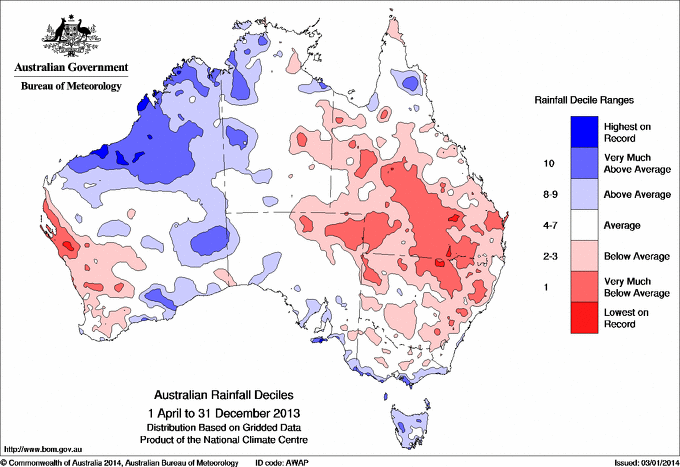Newsletter
January 2014
'Bee Aware' of honey bees
The cotton growing environment can be a high risk environment for bees. The current extended dry means that growers should be vigilant to the presence of honey bee hives in their area. Rainfall in most cotton growing areas has been well below average, as illustrated on the following decile map.

In dry areas, pollen sources in native vegetation will be limited and cotton may be one of the most attractive sources of pollen and nectar left actively growing in the landscape.
Honey bees can travel up to 7 km in search of pollen and nectar when nearby sources are in decline or are of poor quality. Bees collect nectar from cotton’s extra-floral nectaries (e.g. under leaves) as well as from its flowers so they may forage in cotton crops before, during and after flowering.
Cotton is recognised by the honey bee industry as a potentially useful feed source for bee breeding and honey production. The reduced reliance on insecticides in the cotton industry has increased the willingness of some hive owners to place bees in close proximity to cotton.
Use of insecticides and honey bees
Bees are particularly susceptible to many of the insecticides still used in cotton production, such as fipronil, clothianidin, abamectin, indoxacarb and pyrethroids. There are no products for mirid control in cotton that are safe to bees. Even when products such as fipronil are used at well below label rates, toxicity to bees remains very high.
Insecticides that are particularly toxic to bees are identified as such on the label through statements such as; “DO NOT spray any plants in flower while bees are foraging”. These statements make clear the shared responsibility between hive owners and users of insecticide in the protection of bees.
The productivity of hives can be damaged if bees or the hives are contaminated. Bees can be killed or contaminated while foraging in sprayed cotton crops, but damage may also occur if pesticides drift over hives or over neighbouring vegetation being foraged by bees.
During the cotton season, the risk to bees can be reduced by:
- Keeping an eye out for bee hives that may have been placed in vegetation neighbouring your farm. They may be positioned under trees to afford them protection from direct sun.
- Notifying the beekeeper when hives are near crops to be sprayed to allow hives to be removed before spraying. Beekeepers require as much notice as possible to move hives, preferably 48 hours. Where the owner of the hives is not known, contact your State Department of Primary Industries/Agriculture, citing the registration number, for assistance in contacting the owner.
- Informing contract pesticide applicators operating on your property of the locations of hives. The applicator may wish to discuss with you the establishment of a buffer zone to further protect the area.
- Paying particular attention to wind speed and direction, air temperature and time of day before applying pesticides.
- Avoiding drift and contamination of surface waters where bees may drink (see advice on risk management for aquatic organisms).
- Applying pesticides toxic to bees in the evening when bees are not foraging.
- Always following label requirements.
'Bee Alert'
The CottonInfo team Cotton Calendar app includes a ‘Bee Alert’ (Industry Events/Regional Events/My Events/Bee Alert/ RSVP Settings) tab that aims to improve communication between hive owners and cotton growers. This free service allows beekeepers to regularly update information about their hives, with information automatically linked to relevant cotton growers. Cotton growers and aerial spray operators can also use “Bee Alert” to help neighbours ‘bee aware’ when hives have been observed near cotton crops.
Bee hives are entered as a special event type, with GPS co-ordinates of hives as well as start date, likely duration, number of hives and contact details. Calendar App users in the vicinity will be advised to “Bee Aware”. Communication with growers and aerial operators can then be coordinated locally.
The cotton industry, through CottonInfo and Cotton Australia, is working with the Apiarist and Crop Pollination industry groups to encourage hive owners to use “Bee Alert” when they are placing hives near cotton crops.
For more information on how to access the Cotton Calendar App or to use the ‘BEE Alert’ tab contact Dave Larsen, NSW DPI 02 6799 1534.
myBMP
The Australian Cotton Industry’s Chemical Handlers Application Management Plan for 2013/14 can be found as a grower resource in the myBMP Pesticide Management module - www.mybmp.com.au
Key points for bee protection;
- Registered Pesticide labels carry specific bee warnings if the product is toxic to bees along with appropriate precautions and requirements.
- Commercial apiarists may operate over large areas and may not be able to initiate protective action over their bees at short notice.
- Commercial apiarists may seclude hives from view to avoid theft or direct sun exposure.
- Local Land Services (NSW) travelling stock reserves may have dedicated ‘Bee Sites’.
- All beehives must be registered with NSW DPI in NSW or QLD DAFF in Queensland.
Products under review
The Australian Pesticides and Veterinary Medicines Authority (APVMA) has a Chemical Review Program which can reconsider the registration of agricultural and veterinary chemicals in the marketplace if potential risks to safety and performance have been identified. Both fipronil and the neonicotinoid chemical group (clothianidin, imidacloprid and thiamethoxam) are currently under review. Honey bee health is a focal point in both reviews and was a significant consideration in the European Commission’s decision last year to implement a two year suspension of all uses of three neonicotinoids (clothianidin, imidacloprid and thiamethoxam) in flowering crops.
With good communication and good will, it is possible for apiarists and cotton growers to work together to minimise risks to bees, without the loss of access to these products.
For more information on products that are harmful to bees, and how to minimise the risk to honey bees refer to the CottonInfo fact sheet located at www.myBMP.com.au